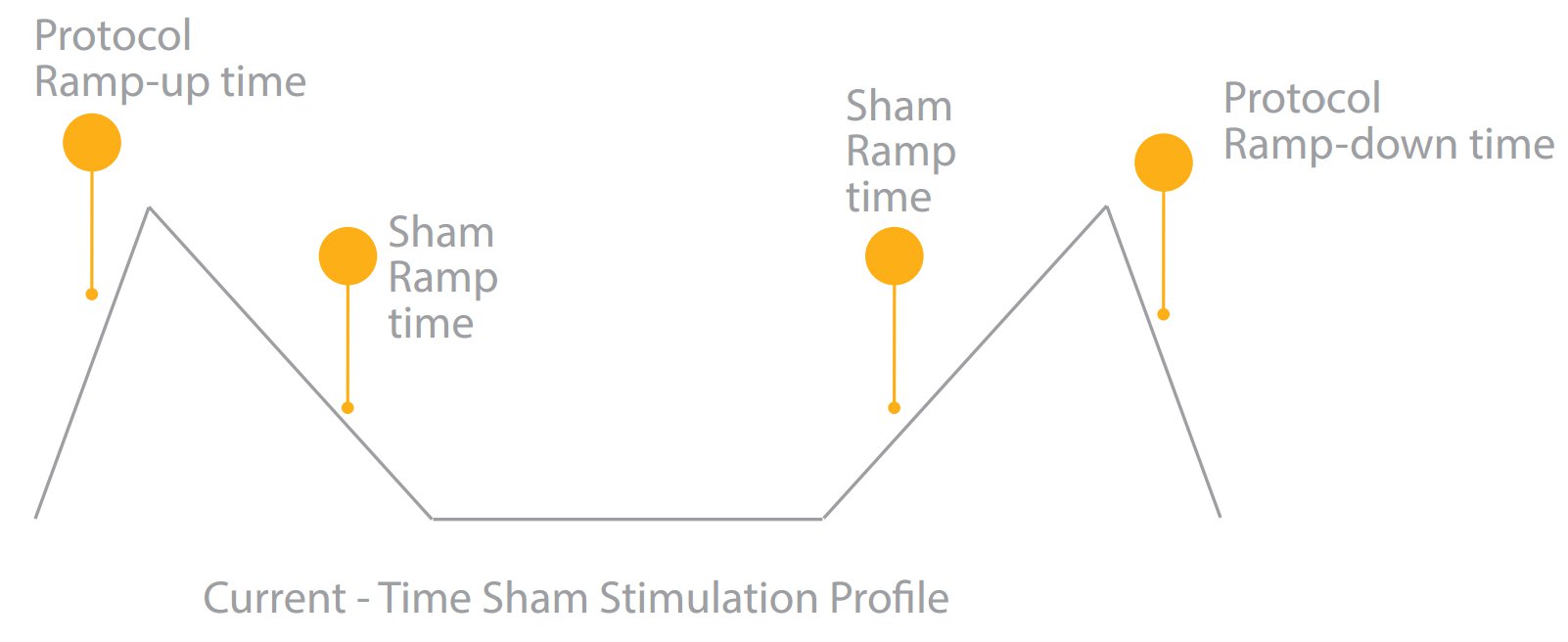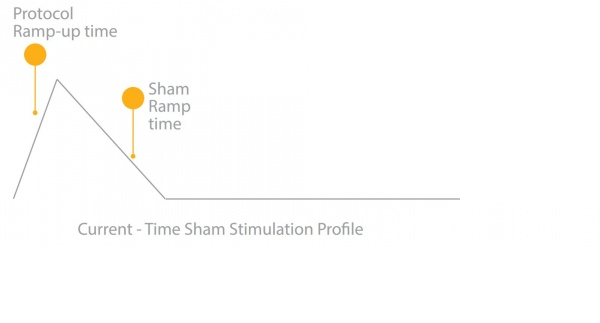Difference between revisions of "About Sham and Double-blind experiments"
(→References) |
|||
| (4 intermediate revisions by the same user not shown) | |||
| Line 32: | Line 32: | ||
This method ensures double blinding and delivers similar PNS stimulation across conditions, so putative PNS effects will be present in both active and sham stimulation. The Actisham method has been already been used successfully in previous work (Dagan et al, 2018), i.e., by blinding the subjects efficiently while not producing behavioral effects in freezing of gait tasks in Parkinson’s disease patients. When comparing the different types of stimulation conditions, no significant difference was found in the number of subjects who reported real or sham. The confidence levels were also similar after real and sham responses. | This method ensures double blinding and delivers similar PNS stimulation across conditions, so putative PNS effects will be present in both active and sham stimulation. The Actisham method has been already been used successfully in previous work (Dagan et al, 2018), i.e., by blinding the subjects efficiently while not producing behavioral effects in freezing of gait tasks in Parkinson’s disease patients. When comparing the different types of stimulation conditions, no significant difference was found in the number of subjects who reported real or sham. The confidence levels were also similar after real and sham responses. | ||
| + | |||
| + | [[File: shunting.png|600px]] | ||
| + | |||
| + | Figure 1: Physics of shunting. E-field magnitude and direction in the tissues beneath the electrodes in the two optimized montages used in this study: active 4-channel montage (left) and ACTISHAM 6-channel montage (right). Actisham takes advantage of current shunting through the scalp to place the electrodes and decrease the E-field in the target M1 area. The magnitude of the E-field (in V/m) is, therefore, much higher in the active montage, despite the injected current being similar across both montages | ||
| + | |||
| + | [[File: actishamontages.png|600px]] | ||
| + | |||
| + | Figure 2: Normal component of the electric field (En, in V/m) induced in the GM surface by a: (a/d) bipolar tCS montage with 35 cm2 sponges located over C3 and FP3 (I=±2.0 mA); (b/e) optimized 4-channel montage with PISTIM electrodes; (c/f) Actisham 6-channel montage. Anodes are shown in red, cathodes in blue and inactive electrodes in white. | ||
| + | |||
| + | == References == | ||
| + | |||
| + | Miranda PC, Mekonnen A, Salvador R, Ruffini G. The electric field in the cortex during transcranial current stimulation. Neuroimage 2013;70:48–58. | ||
| + | |||
| + | Ruffini G, Wendling F, Merlet I, Molaee-Ardekani B, Mekonnen A, Salvador R, et al. Transcranial current brain stimulation (tCS): Models and technologies. IEEE Trans Neural Syst Rehabil Eng 2013;21:333–45. | ||
| + | |||
| + | Ruffini G, Fox MD, Ripolles O, Miranda PC, Pascual-Leone A. Optimization of multifocal transcranial current stimulation for weighted cortical pattern targeting from realistic modeling of electric fields. Neuroimage 2014;89:216–25. | ||
| + | |||
| + | Kessler SK, Turkeltaub PE, Benson JG, Hamilton RH. Differences in the experience of active and sham transcranial direct current stimulation, Brain Stimulation 5(2) (2012) 155-62. | ||
| + | |||
| + | Wallace D, Cooper NR, Paulmann S, Fitzgerald PB, Russo R. Perceived Comfort and Blinding Ecacy in Randomised Sham-Controlled Transcranial Direct Current Stimulation (tDCS) Trials at 2 mA in Young and Older Healthy Adults, Plos One 11(2) (2016) e0149703. | ||
| + | |||
| + | Dagan M, Herman T, Harrison R, Zhou J, Giladi N, Runi G, et al. Multi-target transcranial direct current stimulation for freezing of gait in Parkinson's disease, Movement disorders: official journal of the Movement Disorder Society (2018). | ||
| + | |||
| + | Clara FONTENEAU , Marine MONDINO, Martijn ARNS, Chris BAEKEN, Marom BIKSON, Andre R BRUNONI, Matthew J BURKE, Tuomas NEUVONEN, Frank PADBERG, Alvaro PASCUAL-LEONE, Emmanuel POULET, Giulio RUFFINI, Emiliano SANTARNECCHI, Anne SAUVAGET, Klaus SCHELLHORN, Marie-Françoise SUAUD-CHAGNY, Ulrich PALM, Jérome BRUNELIN, Sham tDCS: a hidden source of variability? Reflections for further blinded, controlled Trials, to Appear in Brain Stimulation (2019) | ||
Latest revision as of 16:56, 8 January 2019
With Starstim you can easily implement "sham" stimulation session and also double-blind experiments.
Sham
In tCS, Sham refers to creating an experience for the subject akin to real stimulation, without actually applying significant currents. The subject believes he/she is being stimulated normally, but there should not be any real effects. The goal is to control for placebo effects in treatment. Whether you are doing a doble or single-blind experiment, stimulation sham mode is needed to control for placebo effects. With Starstim, Sham mode is implemented by ramping up and down the current envelope at the beginning/end of stimulation respectively, as it is during these times when the subject can feel the strongest sensations during stimulation. This modulation of the envelope of stimulation applies to tDCS, tACS and tRNS components of the stimulation. The setting of the Sham ramp time depends on the protocol and sensations of the patients, therefore it can be adjusted.
Below there are the pictures to show a normal Stimulation profile and a Sham Stimulation profile.
Normal Stimulation Profile:
Sham Stimulation Profile:
In addition,it is possible to disable the sensations at the end of the session by activating in the software the Single Ramp option:
In a Sham Stimulation profile, the Launch window figure in setting looks like a Normal Stimulation Profile that simply to "fool" the subject in case they are viewing the stimulation protocol but in reality the protocol corresponds to the figure above.
Single and Double Blinding
In single-blind trials, the operator knows which stimulation type is being applied, but the subject doesn't.
In double-blind experiments, the goal is to have both operator and subject blind to which type of stimulation is being applied (e.g., active vs. sham, or anodal vs. cathodal, etc). See our NIC2 manual [1] (page 56) for more information on how to configure your experiments and NIC for Sham and double-blind trials.
Actisham
The Stimweaver optimization approach can also be used to extend and improve upon the concept of sham, an approach we call the active sham or ACTISHAM for short. Traditional sham in tDCS is implemented by ramping-up and down the tDCS currents during a short period of time (e.g., 30 s) at the beginning and end of the protocol. The rationale for this approach is that most subjects will experience the strongest sensations associated with currents during the first part of a stimulation session. However, this method is not without criticism: in addition to creating imperfect subjective effects (Kessler et al 2012, Wallace et al 2016) classical ramp-up/ramp-down sham is not efficient in two other important aspects. First, the effects on the peripheral nervous system (PNS) are quite different across active and sham conditions, which could mask PNS effects in the active condition. Second, induced skin redness under the electrode, which is not uncommon in the active condition, makes double-blinding more challenging. Finally, although the currents are ramped down after a short time, cortical effects may still be induced.
With Actisham, the same electrode montages are used across conditions to ensure double blinding, and only the individual currents at each electrode are changed. In the active sham condition, currents are configured to produce similar itching to the active condition, but very low cortical electric fields. Physically this is possible by maximizing current shunt through the scalp. This is achieved by the use of the optimization algorithm (Stimweaver), which has now the objective of a null electric field on the cortical target, with the additional constraint that some electrodes deliver sizable currents (e.g., 1 mA). The active sham montages typically involve alternating anodes/cathodes, forming a criss-cross pattern in the case of the motor strip for instance.
This method ensures double blinding and delivers similar PNS stimulation across conditions, so putative PNS effects will be present in both active and sham stimulation. The Actisham method has been already been used successfully in previous work (Dagan et al, 2018), i.e., by blinding the subjects efficiently while not producing behavioral effects in freezing of gait tasks in Parkinson’s disease patients. When comparing the different types of stimulation conditions, no significant difference was found in the number of subjects who reported real or sham. The confidence levels were also similar after real and sham responses.
Figure 1: Physics of shunting. E-field magnitude and direction in the tissues beneath the electrodes in the two optimized montages used in this study: active 4-channel montage (left) and ACTISHAM 6-channel montage (right). Actisham takes advantage of current shunting through the scalp to place the electrodes and decrease the E-field in the target M1 area. The magnitude of the E-field (in V/m) is, therefore, much higher in the active montage, despite the injected current being similar across both montages
Figure 2: Normal component of the electric field (En, in V/m) induced in the GM surface by a: (a/d) bipolar tCS montage with 35 cm2 sponges located over C3 and FP3 (I=±2.0 mA); (b/e) optimized 4-channel montage with PISTIM electrodes; (c/f) Actisham 6-channel montage. Anodes are shown in red, cathodes in blue and inactive electrodes in white.
References
Miranda PC, Mekonnen A, Salvador R, Ruffini G. The electric field in the cortex during transcranial current stimulation. Neuroimage 2013;70:48–58.
Ruffini G, Wendling F, Merlet I, Molaee-Ardekani B, Mekonnen A, Salvador R, et al. Transcranial current brain stimulation (tCS): Models and technologies. IEEE Trans Neural Syst Rehabil Eng 2013;21:333–45.
Ruffini G, Fox MD, Ripolles O, Miranda PC, Pascual-Leone A. Optimization of multifocal transcranial current stimulation for weighted cortical pattern targeting from realistic modeling of electric fields. Neuroimage 2014;89:216–25.
Kessler SK, Turkeltaub PE, Benson JG, Hamilton RH. Differences in the experience of active and sham transcranial direct current stimulation, Brain Stimulation 5(2) (2012) 155-62.
Wallace D, Cooper NR, Paulmann S, Fitzgerald PB, Russo R. Perceived Comfort and Blinding Ecacy in Randomised Sham-Controlled Transcranial Direct Current Stimulation (tDCS) Trials at 2 mA in Young and Older Healthy Adults, Plos One 11(2) (2016) e0149703.
Dagan M, Herman T, Harrison R, Zhou J, Giladi N, Runi G, et al. Multi-target transcranial direct current stimulation for freezing of gait in Parkinson's disease, Movement disorders: official journal of the Movement Disorder Society (2018).
Clara FONTENEAU , Marine MONDINO, Martijn ARNS, Chris BAEKEN, Marom BIKSON, Andre R BRUNONI, Matthew J BURKE, Tuomas NEUVONEN, Frank PADBERG, Alvaro PASCUAL-LEONE, Emmanuel POULET, Giulio RUFFINI, Emiliano SANTARNECCHI, Anne SAUVAGET, Klaus SCHELLHORN, Marie-Françoise SUAUD-CHAGNY, Ulrich PALM, Jérome BRUNELIN, Sham tDCS: a hidden source of variability? Reflections for further blinded, controlled Trials, to Appear in Brain Stimulation (2019)




